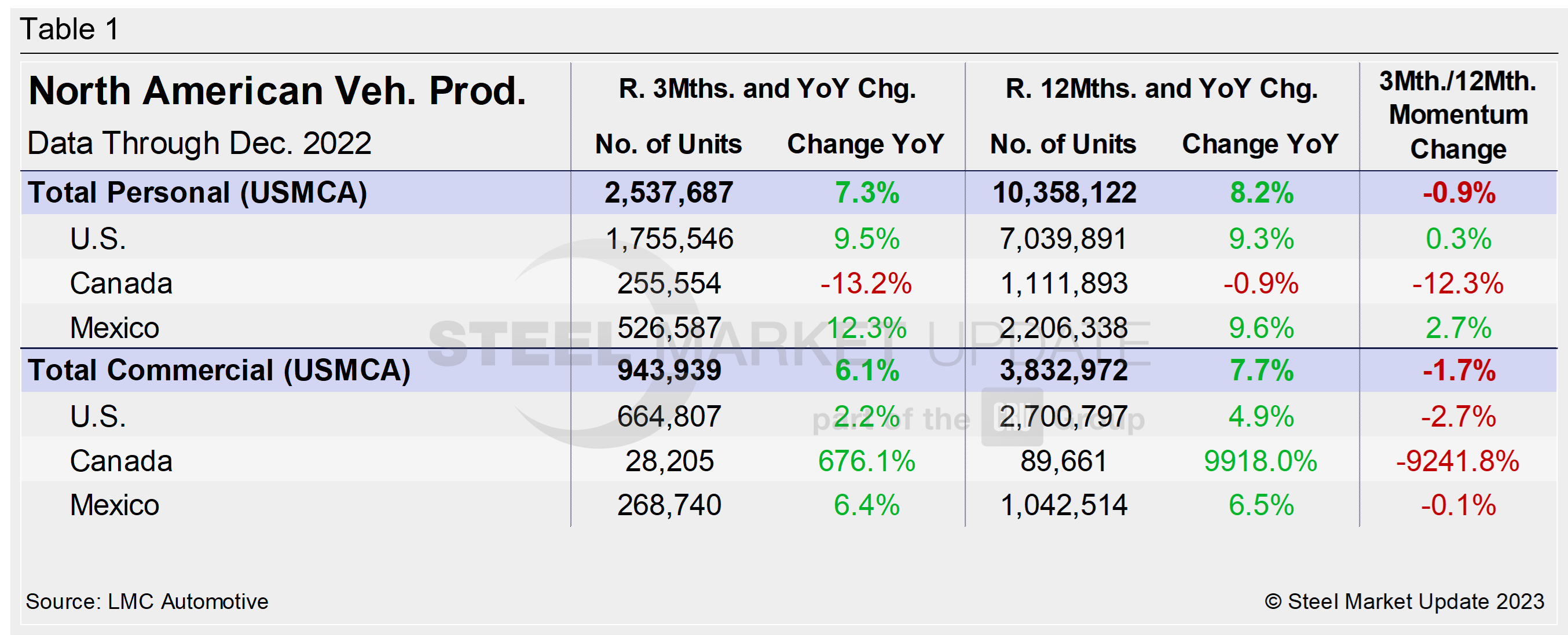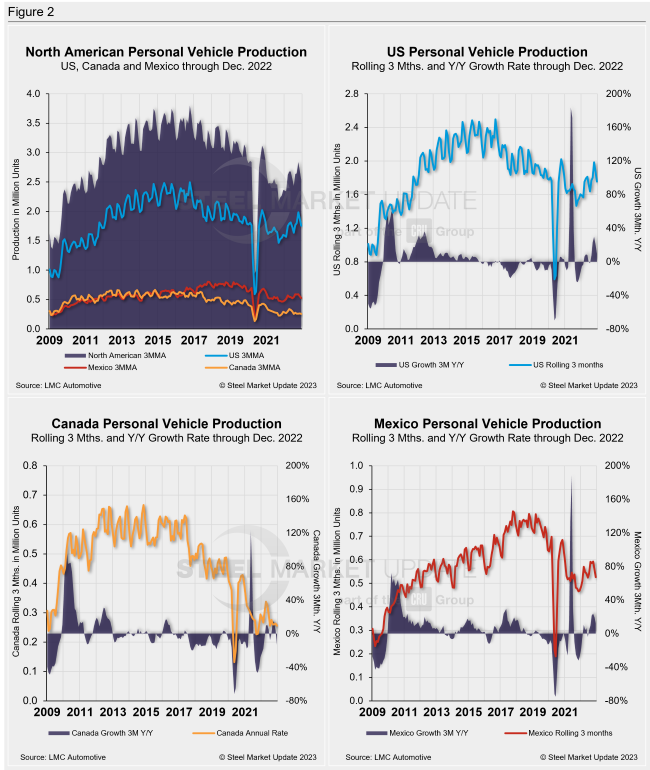Mexico
January 18, 2023
North American Auto Assemblies Fall Further in December
Written by David Schollaert
North American auto assemblies declined 13.8% in December, slowing down for the second straight month. Last month’s assembly output was the second-lowest total in 2022 and just 3.4% higher year on year (YoY), according to LMC Automotive data.
December finished as the third consecutive month at more than one million units. Though inventories have improved, the market remains supply-constrained due to ongoing parts and supply shortages. The trend continues to push new-vehicle transaction prices higher, albeit at a slower pace than earlier this year.
The impact of the global semiconductor crisis on the North American automotive market was extensive, at times nearly bringing the industry to a halt. The early onset of the pandemic certainly slowed auto assemblies. However, the chip scarcity led to extensive production halts, delays, and inventory shortages.
Though at times slow, the recovery has been notable, especially over the past few months. But repeated declines in November and December’s production totals underscore there is still ground to be made up. When compared to the last “normal” year in 2019, production is down just 1.9%, a notable shift from a month prior when assembly totals were 11.8% behind.
North American vehicle production, including personal and commercial vehicles, totaled 1.033 million units in December, down from 1.199 million units in November, but better than the 999,515 units produced one year ago.
Below in Figure 1 is North American light-vehicle production since 2009 on a rolling 12-month basis with a YoY growth rate. Also included is the average monthly production, which includes seasonality since 2013.

A short-term snapshot of assembly by nation and vehicle type is shown in the table below. It breaks down total North American personal and commercial vehicle production into US, Canadian, and Mexican components. It also includes the three- and 12-month growth rates for each and their momentum change.
The initial recovery from Covid’s early spread was significant, but the effect of the chip and parts shortage has been more extensive and prolonged. Through last September, growth rates for personal and commercial light vehicles were -25.8% and -8.4%, respectively. They have since recovered nicely, both posting steady gains.
For the three months through December, the growth rate for total personal and commercial vehicle assemblies in the USMCA region is up noticeably. On a 12-month basis, the story is a bit different but still improving.

Personal Vehicle Production
The longer-term picture of personal vehicle production across North America is shown below. The charts in Figure 2 show the total personal vehicle production for North America and the total for the US, Canada, and Mexico. Personal vehicle production in these three countries and their YoY growth rate are also displayed.
In terms of personal vehicle production, the region saw a month-over-month (MoM) decrease in December.
The US saw the largest decrease in units produced in December vs. November, down 57,651 units (-9.9). It was followed by Mexico, down 33,593 units (-17.9%), and Canada, down 28,199 units (-26.3%) MoM.
Despite the negative results last month for the region, the annual growth rate in December was mixed. Mexico was ahead last month, showing a 12.3% growth rate, followed by the US, still expanding at 9.3% despite the MoM decline, while Canada’s growth rate was down 13.2%.
Production share across the region was largely unchanged. The US saw its personal vehicle production share of the North American market edge down by 0.3 percentage points to 69.2%. Mexico was up just 0.1 percentage point to a regional market share of 20.8%, and Canada was up 0.3 percentage points to 10.1%, respectively.

Commercial Vehicle Production
Total commercial vehicle production for North America and the total for each nation within the region are shown in the first chart in Figure 3 on a rolling three-month basis. Commercial vehicle production in the US and Mexico and their YoY growth rates, as well as the production share for each nation in North America, are also shown.
Of note for the Canadian automotive sector: December marked the 14th month since Canada resumed commercial vehicle production after a 20-month production halt. Canada produced 8,286 light commercial vehicles in December, a 22.5% decrease from November, the highest total since resuming production in November 2021.
North American commercial vehicle production was down by 14.2% in December with a total of 277,920 units produced during the month, a decrease of 45,992 units MoM. This is the lowest monthly total for 2022. The US saw the largest decline MoM (-26,277 units, or -11.7%), followed by Mexico (-17,311 units, or -19.4%), and Canada (-2,404 units, or -22.5%).
The overall decline put the commercial production growth rate at 6.1% for the region. Though down more than 40% MoM, the result was still a vast improvement from the -8.4% growth rate seen a year ago.
The market share across the region was unchanged. The US held nearly three-quarters of the market, with a total share of 70.4%, followed by Mexico with a 26.6% share, and Canada with a 3% share in December.
Presently, Mexico exports just under 80% of its light-vehicle production. The US and Canada are the highest-volume destinations for Mexican exports.

Editor’s Note: This report is based on data from LMC Automotive for automotive assemblies in the US, Canada, and Mexico. The breakdown of assemblies is “Personal” (cars for personal use) and “Commercial” (light vehicles less than 6.0 metric tons gross vehicle weight rating; heavy trucks and buses are not included).
By David Schollaert, David@SteelMarketUpdate.com







